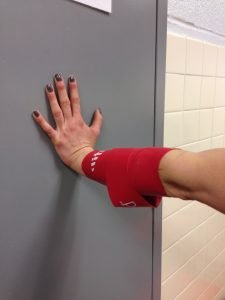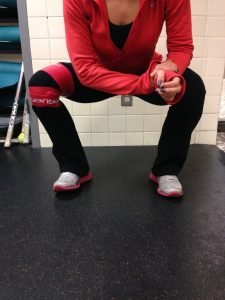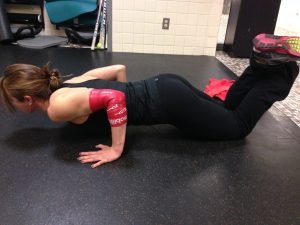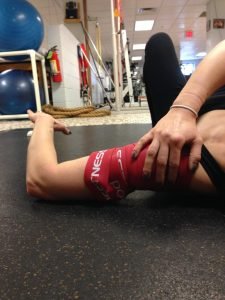Floss Everyday:
How (and When) to Use a VooDoo Band.
Most athletes know that foam rollers and lacrosse balls are excellent tools for soft tissue mobilization. But what about the VooDoo floss band? Or if you are a CrossFit Love member, we have the various lengths of donated bike tires that have been cut in half length-wise and live in the bucket of lacrosse balls. Those work just as well. I see people wrapping them around all sorts of injuries and ailments without knowing how to use them properly. It can be the one of the most effective mobility tools in your bag when used correctly, so I want to share the basics to proper usage.
Background (Science-y Stuff)
Do you remember the acronym R.I.C.E. from your First Aid class? Rest-Ice-Compression-Elevation. Most people remember the ice piece of that. When you sprain your ankle playing basketball, ICE. When your wrist is sore from practicing handstand push-ups, ICE. When you strain your quad doing sprints, ICE. When you miss the box during box jumps and cut your shin open, ICE. There has been more and more research coming out that ice may not be as effective for treating injuries (other than for pain control by making the area numb) as we once thought. Even when it comes to muscular soreness and stiffness after a tough workout, compression seems to be the most effective way to combat the effects.
So how does it work? From your experience with foam rolling and lacrosse balls, you know that compression causes trigger points to release. Incorporating motion with those techniques increases the effectiveness by restoring the sliding surfaces of the muscle fibers and surrounding tissues. Using a stretch band when mobilizing increases range of motion because it creates a joint distraction force allowing for more joint spacing during the movement, therefore allowing more movement. You also know that massaging or compressing a swollen or inflamed area decreases the swelling by pushing the inflammation back into circulation via the lymphatic system. VooDoo floss accomplishes all of these goals and then some, in about two minutes. Think of it as a circumferential foam roller that adds compression and joint distraction, and allows you to go through a FUNCTIONAL movement pattern. Because after all, isn’t our goal to be more functional?
When to use (Goals)
- Decrease soreness and loss of motion after exercise: One of my go-to uses for VooDoo floss is to save my forearms after “Helen” or calves after a long run. Flossing after a high volume of work on one body part pushes the inflammation caused by exercise back into circulation, and prevents the “my forearms are about to explode” feeling the following day.
- Break up adhesions and scar tissue: VooDoo floss is extremely effective at breaking up adhesions that build up from years of poor movement; think tendonitis (Achilles, patellar, golfers elbow). Flossing creates a “shearing” force across the tissue, essentially helping it to re-align and restore normal motion and increase blood flow.
- Decrease swelling: Compression of a swollen area pushes the inflammation back into the lymphatic system to be reabsorbed by the body. Swelling is a common cause for loss of range of motion or “tightness” after an injury.
- Increase range of motion in and stretch hard to reach areas around joints: One of the biggest advantages to using VooDoo bands is the ability to go through a FUNCTIONAL range of motion. Bending and straightening your knee while foam rolling your IT band helps, but is not as functional as squatting or lunging in a good position.


How to use (Instructions)
- When using the VooDoo band for decreasing swelling, wrap joint towards the heart.
- Overlap band by half.
- Apply band with about 50% tension and 75% tension over the targeted area.
- Incorporate motion gradually and make sure that you are in a good position, ie. Squatting with a vertical shin, knees out, and feet flat, or doing a dip with a vertical forearm and rotating around the elbow. Mobilizing in a bad position only reinforces bad habits; always mobilize into the position you are trying to achieve.
- Don’t force the movement. “Floss” the joint through a good movement pattern and try to increase range of motion with each repetition.
- Make the movement functional. Do a push up or pull up, squat, lunge, or overhead press, but make sure it is correct and through a full range of motion.
- To increase range of motion of a joint, try wrapping one band above the joint and one below. Then go through a movement pattern, squat, do a push up, lunge, or dip; whatever your goat.
- Remove the band after about two minutes and allow the tissue to recover and re-vascularize.
How NOT to use (Contraindications)
- Remove band after about two minutes; OR
- Remove band if you feel numbness, tingling, or “pins and needles”.
- Remove band if extremity turns white or grayish.
- Using a VooDoo band isn’t exactly the most comfortable thing, but make sure you remove the band if you feel any PAIN.
- Do NOT use on the face, head, neck, or around your waist/chest. I feel like this should go without saying, but I have seen people try some strange things.


My FAVORITE uses (Try these out if you haven’t already)
- Decreasing swelling and inflammation. Like I mentioned before, the first thing I run for after finishing “Fran” or “Helen” is my floss band to prevent my forearms from exploding. Try wrapping your forearms and putting your wrists through a range of motion by pressing against a wall. Turn your elbows up and down with your palms against the wall. This technique also works on the lower leg and calf after double-unders, box jumps, or running; quadriceps after tabata air squats; or triceps after a push-up workout.
- Breaking up adhesions at the elbow and knee. Wrapping over the patellar tendon, IT band, or wrist extensor/flexor complex works wonders for tendonitis at those joints. Try wrapping either joint and doing a PERFECT squat, lunge, push up, press, or dip.
- Increasing shoulder range of motion. Try wrapping the VooDoo band around the deltoid and shoulder complex and reinforcing good shoulder and scapular positioning on the floor, put the shoulder through a full internal and external rotation motion.
- Opening up the hip girdle. Try wrapping the VooDoo band around your hip crease. Do a few squats, side to side lunges, or even the pigeon or adductor stretch.
- Stretching the Achilles in those hard to reach spots. Try wrapping half of the band around your foot and the other half around your lower calf. Then do a few toe raises and downward dogs stretches pushing your heels to the floor.
- Using with a half-lacrosse ball to relieve trigger points in large muscle groups. Try wrapping a half-lacrosse ball with an x-pattern to apply direct pressure to spasms in lower legs, quadriceps and hamstrings, biceps/triceps and forearms. It is like being able to move around and through a position of restriction with a foam roller attached.

—-A word of warning when trying to cut a lacrosse ball in half: A saw of any sort is NOT a good idea. I halved mine after a lawnmower got ahold of one. I just finished the job with some scissors.—-
Again, these are a just a few of the uses for this tool. Please feel free to share any others you have had success with. And a friendly reminder, don’t just mobilize the painful tissue or joint. Look ABOVE and BELOW the site of pain for the problem or restriction!
Photos
- Forearm – wall
- Knee – squat
- Hip – side lunge
- Achilles – above/below
- 1/2 lax ball – Quad/hamstring
- Elbow – dip/pushup
- Elbow – dip/pushup
- Shoulder – IR/ER



Mischa Jemionek, MA, ATC, CSCS, CES, CrossFit Level 1
Assistant Athletic Trainer
Princeton University